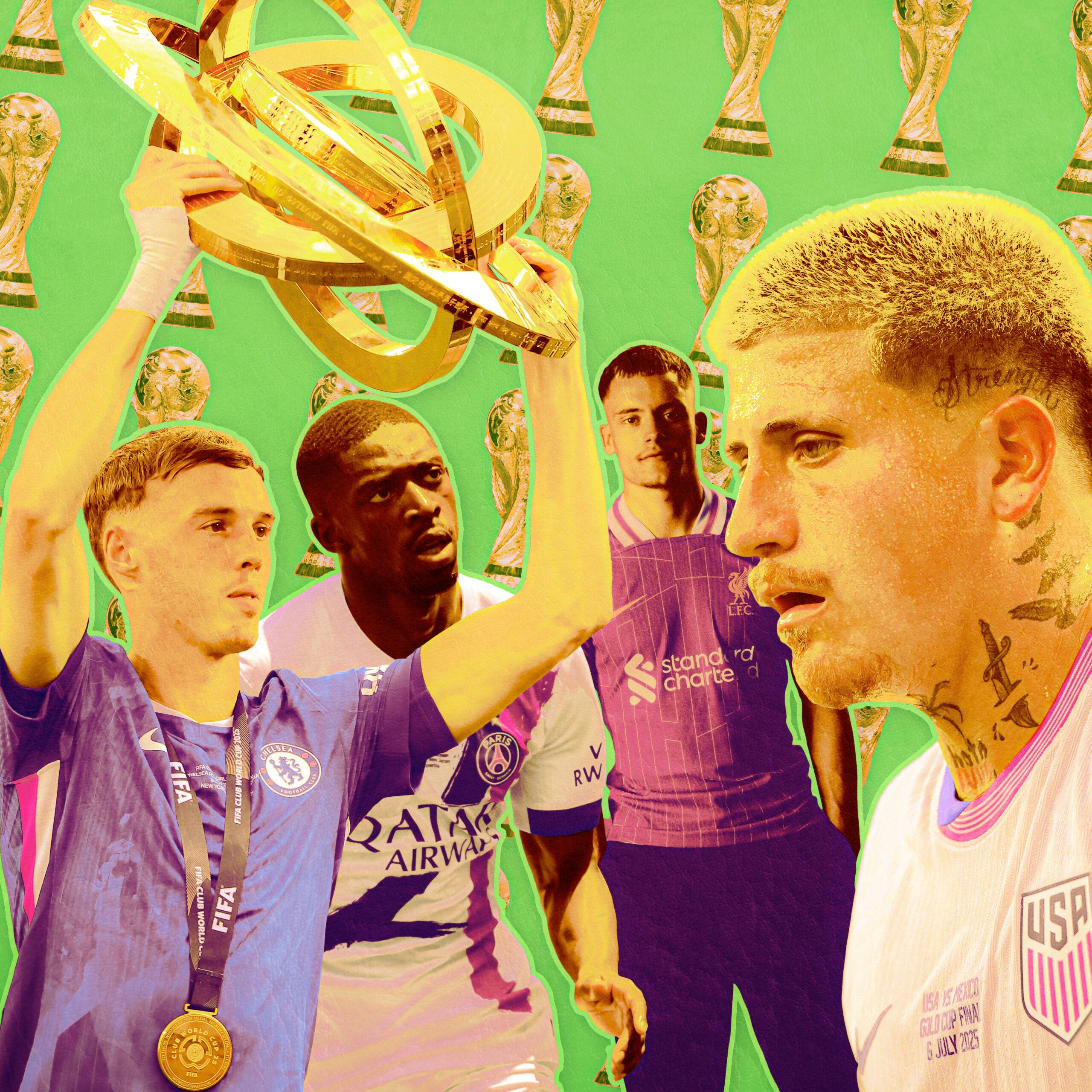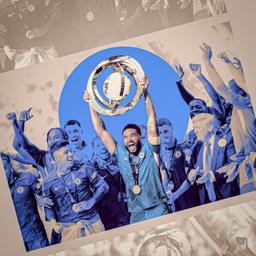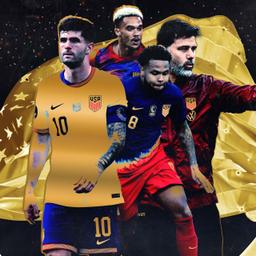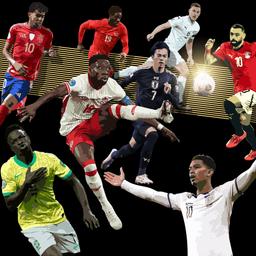
Welcome to The Ringer’s World Cup Countdown—a monthly column previewing the 2026 World Cup hosted in the United States, Canada, and Mexico.
In less than a year, 48 teams will converge in North America to compete for the world’s greatest sporting prize. It all kicks off on June 11, 2026, and between now and then, we’ll cover everything shaping the tournament, from the U.S. men’s national team to the stars and story lines abroad that will define qualifying and the buildup to the first kickoff.
Host cities, breakout players, managerial chaos, kit reveals, the group stage draw—if it’s part of the World Cup lead-up, it’s on the table. Consider this column your monthly check-in. Same time next month?
The Big Thing: What We Learned From the Club World Cup as an Appetizer to the Main Course Next Summer
Maybe it was a money grab. Maybe it was too much soccer. Maybe it was a somewhat plastic tournament with no clearly defined stakes. But of all the criticisms leveled at FIFA’s expanded Club World Cup, one in particular has stuck with me—the decision to host games at the peak of the excessive American summer heat, which will be just as relevant when the actual World Cup kicks off next year.
Remember Bayern Munich and Borussia Dortmund substitutes sitting in the dressing room while the game was being played just to avoid the sweltering heat in Charlotte and Cincinnati? Dortmund manager Niko Kovac compared the experience to being in a sauna. There were group stage matches in Miami, D.C., and Philadelphia where temperatures exceeded 90 degrees at kickoff, and that doesn’t even account for humidity and how hot it felt on the field itself.
FIFA does not want to schedule concurrent matches at next year’s World Cup—except on the final day of group play—but it’s facing a crunch to try to fit 104 soccer matches into a 39-day window. For most of the group stage, there will be four games per day. Naturally, scheduling games at 12 p.m., 3 p.m., 6 p.m., and 9 p.m. ET would help FIFA properly space out the games. But is it safe to host midday soccer matches in the middle of a U.S. summer? (The 1994 World Cup, also hosted in the States, remains the hottest on record, and climate change has only gotten worse.) In Atlanta, Houston, and Dallas, domed stadiums with climate-controlled environments will help alleviate these concerns. As for games scheduled in places like Miami, Los Angeles, Kansas City, Philadelphia, New Jersey, Monterrey, Guadalajara, and Mexico City, the heat could certainly impact the safety of the players and the quality of play on the field. Sitting around and praying that a heat wave doesn’t arrive during the tournament—as it did this year—isn’t sound decision- or policy-making.
FIFA scheduled the semifinals and final of the Club World Cup at MetLife Stadium in New Jersey at 3 p.m. ET. It was 95 degrees during the semifinal match between Chelsea and Fluminense, and, at one point, Blues midfielder Enzo Fernández said that he “got a bit dizzy during a play and had to go down to the ground.” He added that “playing in this kind of temperature is very dangerous.” Fernández isn’t the only one who voiced concerns about the conditions. Atlético Madrid’s Marcos Llorente, Manchester City’s Tijjani Reijnders, Real Madrid’s Vinícius Júnior, and PSG’s Vitinha all commented on how difficult it was to play.
The easy solution would be to play as many games as possible at night, especially at the tail end of the tournament, when there are only one or two matches scheduled per day. But that’s where the fork in the road comes for FIFA. An afternoon kickoff in the oppressive heat of the United States might be terrible for the players, event staff, and fans in attendance, but it is beneficial for the television audiences abroad, especially in Europe.
If FIFA is trying to protect players, fans, and event staff as much as possible, it’ll schedule as many day games as possible in the more controlled indoor environments and reserve games in Miami, Kansas City, and other dangerously hot climates for the evening. You can’t totally avoid the heat, but the Club World Cup scheduling seemed to seek out the most adverse conditions possible. After this trial run by FIFA, hopefully it’ll do a better job with logistics next summer.
And yet, despite the sweltering temperatures and the overall skepticism of the tournament, the energy around the Club World Cup served as a small taste of what will be a special and memorable summer next year. The tournament came to Philadelphia, where I live, for eight matches, wrapping up with a quarterfinal clash between Chelsea and Palmeiras at Lincoln Financial Field on July 4. And for those few weeks, the city had so much juice for the beautiful game.
The buzz wasn’t just in the matches themselves—it was in the streets, at the Rocky statue, at the Liberty Bell, and so on. Espérance fans marched down Pattison Avenue before their opener against Flamengo, flags waving, drums pounding. You couldn’t ignore it.
I met three Tunisian fans who had flown from Tunis to New York City, then traveled to Philly. They donned Tunisian flags around their shoulders, visited the tourist spots, and danced in the streets. It was those three fans’ first time in America, and they had plans to fly to Nashville, then back to Philly, just to follow their team across the U.S.
I also met two Corinthians fans who had bought tickets to Chelsea vs. Palmeiras for one reason only: to hate-watch rival Palmeiras. They brought signage and spent the entire match trying to avoid getting their signs confiscated by event security. The smattering of random soccer kits worn around a nearly sold-out stadium served as a history lesson.
FIFA’s expansion of the tournament received fair and warranted criticism, but the cultural collisions, street-level electricity, and unmatched energy of it all infected me with World Cup fever.
And in 2026, we’ll get it across 16 cities and three countries.
State of the States
This section focuses on the United States men’s national team as it prepares to host the World Cup.
Describing the start of the Mauricio Pochettino era as bumpy might be generous. Losses to Panama and Canada in March—with a nearly full-strength squad in the latter stages of the CONCACAF Nations League—squashed any hope of a new-manager bounce. Add in the controversy around Christian Pulisic’s decision to sit out the Gold Cup this summer, and it’s clear the vibes have been off.
The team needed a jolt during this Gold Cup. And for a fleeting moment, the likes of Diego Luna and Malik Tillman delivered it. Matt Freese made a statement with his penalty heroics against Costa Rica. And Chris Richards’s opening header in the Gold Cup final gave fans belief.
But it didn’t last.
The spark fizzled fast in a humbling loss to Mexico—an opponent the U.S. has largely dominated in the 2020s. These Gold Cup results, at best, met baseline expectations. The U.S. beat the teams they should beat—Trinidad and Tobago, Haiti, Saudi Arabia, Costa Rica, and Guatemala—but the performances were just OK. They did the job for the most part, but it didn’t change the mood.
And maybe that’s because this wasn’t the USMNT’s best XI.
The question is, what is the best XI right now? At the moment, I’m not totally sure. And Pochettino probably isn’t either. Upcoming September friendlies against Japan and South Korea—likely with the full-strength squad—will be revealing.
Here’s who I think would start at the World Cup if everyone is healthy.
Goalkeeper: Matt Freese
Defenders: Antonee Robinson, Chris Richards, Tim Ream, Sergiño Dest
Midfielders: Tyler Adams, Weston McKennie, Malik Tillman
Forwards: Christian Pulisic, Folarin Balogun, Tim Weah
Seven of those 11 started in Qatar. Freese is actually playing regular club minutes, which cannot be said about Matt Turner. Ream isn’t the ideal first-choice center back at his age, but no one has stepped up to usurp him. Balogun still flashes high-ceiling potential, but we need to see him healthy and producing at the club level. And Tillman? We’ve rarely seen him perform for the national team before this breakout summer.
The USMNT doesn’t have another competitive game until the World Cup kicks off. In addition to their fall friendlies against Japan and South Korea, they’ll play Ecuador and Australia in October, which, at the very least, are the kind of quality opponents the U.S. should be tuning up against. The Americans showed fight, effort, and pride during the Gold Cup. Let’s see if they can keep that spirit when the USMNT’s best players return to the squad.
Stock Watch
This section focuses on the shifting fortunes of players, managers, and nations who could play a significant role next summer.
Stock up: Florian Wirtz (Liverpool/Germany)
The departure of Trent Alexander-Arnold from Liverpool means the Reds will need to replace a ton of ball progression and chance creation this season. Much of that production will now be placed on the shoulders of club-record signing Florian Wirtz. Wirtz had 21 goals and 23 assists in the Bundesliga over the last two seasons at Bayer Leverkusen and added 10 combined goals in the Europa and Champions Leagues in the same time period. The 22-year-old attacking midfielder has been given a ton of freedom to roam in Julian Nagelsmann’s system for Germany. Wirtz missed Qatar in 2022 with a torn ACL, so 2026 will be his first World Cup appearance.
Stock down: Jamal Musiala (Bayern Munich/Germany)
Musiala broke his leg and suffered a significant ankle injury during a collision with PSG goalkeeper Gianluigi Donnarumma in the quarterfinals of the Club World Cup. He’s expected to miss at least four months, which will cause him to miss most, if not all, of the qualifying matches for Germany. With Wirtz and Musiala in the team together, Germany scored a solid 11 goals in their five Euro 2024 matches. Germany should have no problems qualifying for the World Cup without Musiala, but he’ll be facing a challenge to get back to top form in the mix with a talented German roster. If he does manage to get back to his best and can once again combine with Wirtz, the Germans should score goals in bunches.
Stock up: The first-timers
Thirteen teams have already booked their place at the 2026 World Cup, and two of them are making history.
Uzbekistan and Jordan have qualified for the finals for the first time. Besides generating more money for FIFA, the new 48-team format was designed to expand the global reach of the tournament. Asia, Africa, and North America have been the biggest beneficiaries of the addition of those spots.
Expect more new faces as qualifying continues. With 32 teams reaching the knockout stage, these new entrants will have a real chance of escaping the group, too.
Qualified Teams So Far:
North America: USA, Mexico, Canada (hosts)
South America: Brazil, Argentina, Ecuador
Asia: Japan, South Korea, Iran, Australia, Uzbekistan, Jordan
Oceania: New Zealand
Stock down: Italy’s chances of qualifying
Despite an expanded World Cup, Italy is in real danger of missing out for the third straight cycle. Sixteen UEFA teams will go to North America in 2026, and with automatic qualification reserved for group winners (plus four playoff spots), there’s little margin for error.
Italy opened qualifying with a brutal 3-0 loss to Norway in June, immediately putting themselves in danger. The Norwegians, led by Erling Haaland, have taken all 12 points from their first four matches and now are clear favorites to top the group.
The Italian federation responded by hitting the panic button: They fired manager Luciano Spalletti and hired Gennaro Gattuso. They’ll be desperate to avoid the playoffs after Sweden knocked them out of World Cup contention in 2017 and North Macedonia stunned them in 2022.
Stock up: Ecuador’s stellar defense
Over the coming months, I’ll be weighing in on teams that I think could really surprise or disappoint in 2026. Ecuador will be a trendy dark horse underdog pick, and they’ve earned that role by really impressing during qualifying. They’ve played 16 matches in South American qualifying and conceded only five total goals. With seven wins, seven draws, and just two defeats, only Argentina has tallied more points.
The Ecuadorians have an established identity of stout defense and physical play, which can be brutally effective at muddying up games in tournament settings. You only have to look back to the Copa Ámerica last summer, when they took defending World Cup champions Argentina to a penalty shoot-out. They’re anchored in midfield and defense by Moisés Caicedo (Chelsea), Piero Hincapié (Leverkusen), and Pervis Estupiñán (Brighton), and they have 18-year-old attacker Kendry Páez (Chelsea) as a potential breakout star.
Stock down: Carlo Ancelotti’s tax accounting
Brazilian soccer has been steadily trending downward since losing a penalty shoot-out in the 2022 World Cup quarterfinals to Croatia. Neymar tore his ACL and has left the peak of European soccer. They’ve struggled to find an identity, cycled through managers, and mostly looked uninspired throughout qualifying. When you add in draws to Colombia and Costa Rica at the Copa Ámerica in 2024—plus a quarterfinal loss to Uruguay—Brazil needed a spark.
They hired legendary manager Carlo Ancelotti to restore their aura. Instead, he was convicted of tax fraud and sentenced to a year in prison. He won’t actually do the time as a first-time offender, but this is yet another distraction that dulls the excitement of the new managerial hire.
Awards Spotlight
Each month, the World Cup Countdown selection committee (me) will highlight some of the best, worst, and strangest moments in the sport.
The “Bro Thinks He’s on the Team” Award: President Donald Trump
Trump felt inescapable during the Club World Cup. Remember when he was speaking about sensitive foreign policy issues in front of Juventus players, which gave us this reaction from Weston McKennie? He managed to one-up that moment after the final on Sunday, when he surprised everyone, including Chelsea star Cole Palmer, by hovering around the stage during the lifting of the trophy.
“I knew he was going to be here, but I didn’t know he was going to be on the stand when we lifted the trophy, so I was a bit confused,” Palmer said.
Even FIFA president Gianni Infantino attempted to usher the president out of the way. If you read lips closely, it appears that Chelsea’s Reece James asks Trump if he’s going to leave the stage right after Palmer asks what he’s still doing there. Given how present Trump’s been in the soccer world over the past few weeks, it’ll be interesting to see just how involved he is during the World Cup festivities next summer.
The Holiday Hero Award: João Pedro
Pedro interrupted his summer holiday in Brazil to join Chelsea in the middle of the Club World Cup and made an immediate impact in the final three matches of the tournament. First, he showed off his sensational link-up ability in the quarterfinal against Palmeiras. Next, he showed his caliber as a goal scorer when he curled in the opening goal from outside the box against Fluminense, and he followed that up with a neat little chip to add some flair to Chelsea’s dominant performance against PSG in the final. Pedro is a different style of forward from fellow new signing Liam Delap or the enigmatic Nicolas Jackson, but he was a real difference maker in the business end of this tournament.
Getting into the Brazil team is very difficult given its depth of quality attacking options, but Pedro certainly made a hell of a first impression at his new club and will be looking to get in Brazil’s squad next summer. He has three career appearances for the national team.
The “He Doesn’t Even Go Here” Award: Patrick Agyemang
Agyemang’s journey from D-III college soccer player to MLS starter at Charlotte to USMNT starter in an international tournament is a meteoric rise. His physical tools and bull-in-a-china-shop style of play created some chaos for opposition back lines at the Gold Cup this summer. But his first touch often let him down, and he’s been the subject of a lot of criticism from the fan base. With Folarin Balogun and Ricardo Pepi being injured and Pochettino not picking Josh Sargent, the door was open for Agyemang to take a leading role during the Gold Cup. Now he’s gone from relative unknown to potential World Cup player in less than a year, but his production during the tournament prompts reasonable questions about whether he’ll be good enough to belong in that squad in 11 months’ time.
Extra Time Conclusions
1. Last month, I ranked the 52 teams that could be in the tournament next summer. It was a fun thought exercise that served as a perfect concoction of guesswork, vibes, and forecasts for the notoriously unpredictable CONCACAF and Confederation of African Football qualifying matches. I still had the Americans ahead of Mexico and Canada despite the Americans’ recent bumps in the road.
2. Stat that shouldn’t be possible: Italy hasn’t played in a World Cup knockout match since 2006, when it won the final in a penalty shoot-out against France. After going out in the group stage in 2010 and 2014, the Azzurri then failed to qualify in 2018 and 2022. That Euro 2020 title looks more and more like a recent outlier for a proud but perplexing footballing nation.
3. Most of the casuals will tune in only when the actual tournament begins. But if you really want to lock in for qualifying, inter-confederation playoffs, and more, there’s plenty of action to see over the next year.
Dates to know
September: Qualifying resumes
December: Draw for the group stage
March 2026: Inter-confederation playoffs for the final two spots and UEFA playoffs for the final four European spots
June 11, 2026: Tournament kicks off at Estadio Azteca in Mexico City
July 19, 2026: Final at MetLife Stadium





